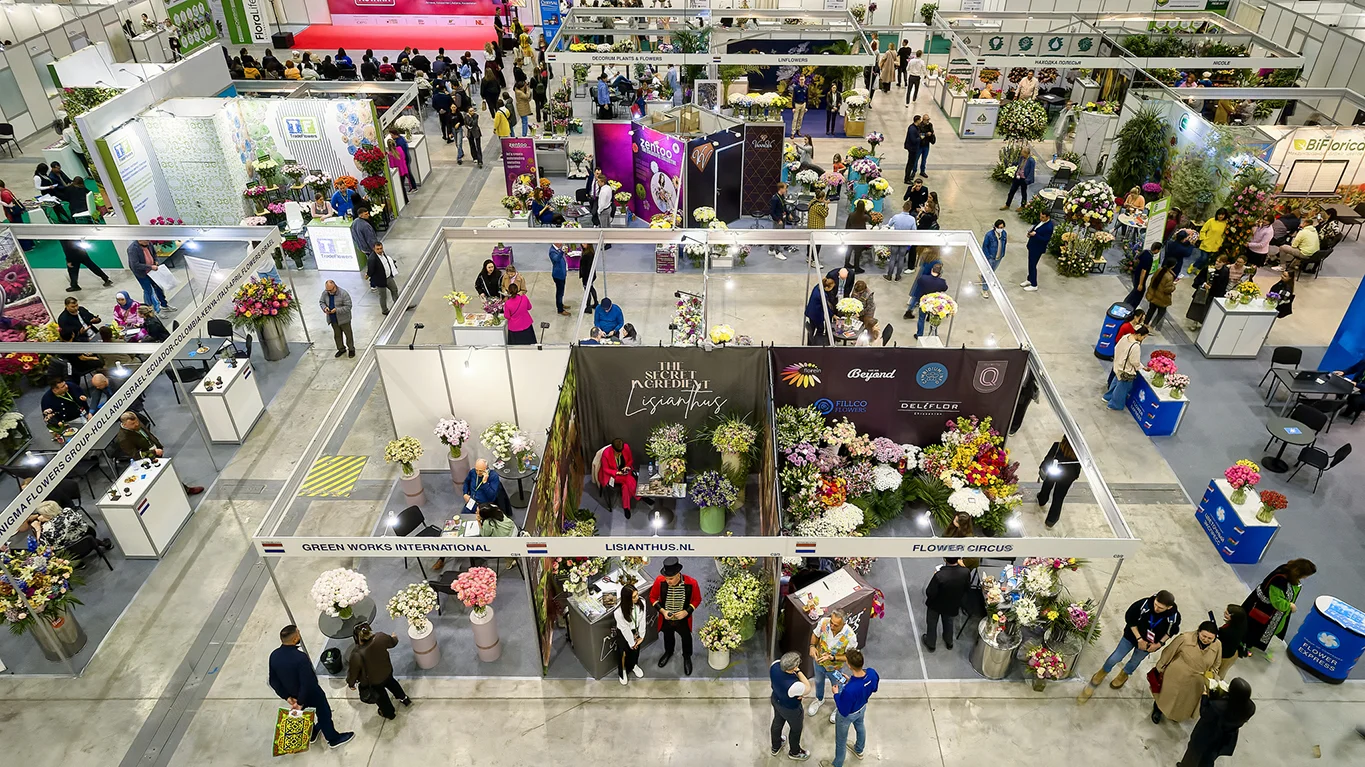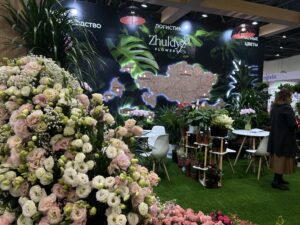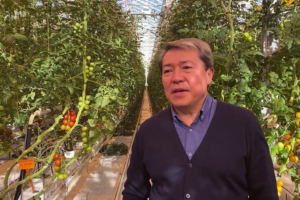ASTANA — The flower industry in Kazakhstan is blooming in terms of imports and domestic production. According to the Bureau of National Statistics, Kazakhstan imported 12,300 tons of cut flowers and buds in 2024, totaling $93.5 million, a significant increase compared to 2023, when imports made 8,200 tons worth $61.2 million.

Kazakhstan imported 12,300 tons of cut flowers and buds in 2024, totaling $93.5 million. Photo credit: Flora Expo
Kazakhstan boasts a rich tradition of flower-giving, where blooms are an integral part of almost every celebration. The bigger the bouquet, the higher the status it carries. This vibrant culture has attracted international suppliers eager to capitalize on the growing demand.
“There is no such flower-giving culture like it is in Kazakhstan (…) There is no real ‘off-season’ in the flower business. Every day is an occasion—a celebration, a birthday, a proposal, or someone trying to mend a mistake with flowers. Every day has its own reason for needing flowers,” said Madi Kairkenov, an expert in the flower business, in an interview with The Astana Times.
He noted that December sees an influx of Norman spruce Nobeles for New Year’s gifts, while tulips lead in March. As spring transitions into summer, lilacs bloom in April and May, followed by peonies in the warmer months.
“However, roses and chrysanthemums remain a constant favorite throughout the year,” he added.
Flora Expo Astana – 2025
The unique culture of flower-giving and the increasing demand has spurred the organization of major exhibitions, such as the Flora Expo Astana 2025, which kicked off on April 8. The three day event featured over 200 companies from 20 countries, including Belarus, Belgium, Germany, Israel, Italy, Kazakhstan, Kenya, China, and the Netherlands.

Flora Expo Astana 2025. Photo credit: Nagima Abuova / The Astana Times
“Flora Expo Astana is an international exhibition of floriculture and landscaping in Kazakhstan and Central Asia. This is the 12th exhibition. This year, we have 200 participating companies from 20 countries, the largest participation since 2010,” director of the Astana Expo exhibition company Kulbagir Kaliyeva told The Astana Times.
According to Kaliyeva, last year’s exhibition focused on greenhouses and generated interest among visitors. This year’s event expanded on the topic, highlighting new solutions in greenhouse automation, climate control, and the digital management of lighting and humidity.
The event featured 25 sessions, showcasing innovative technologies in the floriculture industry, as well as seminars on tulip cultivation, a forum for greenhouse business leaders, and discussions on the potential of Kazakh floristry.
Key flower importers for Kazakhstan

Madi Kairkenov, an expert in the flower business
According to the Bureau of National Statistics, in 2024, flowers were imported from 53 countries. Ecuador is a key exporter of flowers to Kazakhstan, mainly supplying roses and lilies. Last year, its share of the flower imports to Kazakhstan comprised 54.3% of the market, totaling 6,500 tons of flowers worth $50.8 million.
The Netherlands, Kazakhstan’s second-largest supplier, sent 2,300 tons of flowers, mainly chrysanthemums. The total value of Dutch imports to Kazakhstan last year was $17.6 million.
China has also emerged as a significant player in Kazakhstan’s flower market. The country’s market share surged from 1% to 8% in 2024, with a 12.2-fold increase in shipments, amounting to 1,100 tons of flowers.
Among other major suppliers, Columbia and Kenia supplied 978 and 975 tons of flowers, respectively.
Kairkenov noted that Kazakhstan’s import share is approximately 80-85%, while the local share is 10-15%.
“Kazakhstan’s climate is well-suited for flower cultivation. With proper investments from foreign investors and with proper technological processes, we have a great potential to enter and advance flower production,” he said.
Rising local production: greenhouses and technological advances

Zhuldyz Flowers stand at Flora Expo Astana. Photo credit: Nagima Abuova / The Astana Times
Although imports still dominate the market, local flower production also showed strong growth potential. In 2024, Kazakhstan’s farmers harvested 40.3 million flowers, a 3.7-fold increase from the previous year. Greenhouse farming has played a crucial role in this increase, with 33.4 million flowers grown indoors, marking a 5.2-fold jump from 2023.
One of the local producers, Zhuldyz Flowers, grows various flowers, including tulips, peonies, and lisianthuses.
“We grow tulips in the open field and supply them both within Kazakhstan and to neighboring countries. Tulips are particularly popular around International Women’s Day, and we grow around two to three million tulips annually,” said a company representative.
Kazakhstan’s main greenhouses for growing flowers are in Almaty, Shymkent, and Taraz.

Nurlan Adilkhan, a president of the Greenhouse Union of Kazakhstan. Photo credit: agroberichtenbuitenland.nl
“We have transitioned from traditional plastic greenhouses to high-tech glass structures equipped with lighting systems and bio-protectors that fight pests. These technologies help us grow healthier plants. It is a costly business, but with proper management and investment, it has great potential,” president of the Greenhouse Union of Kazakhstan, Nurlan Adilkhan told The Astana Times.
“Flowers are always in demand here. It is not just a bunch of roses wrapped in newspapers any more that our generation saw. Today, the market is huge. The colors are very diverse. There are so many flowers, thousands and thousands of varieties,” Adilkhan added.
Kairkenov, also involved in developing local flower production, said that his team purchased 900,000 tulip bulbs from the Netherlands this year, most of which were grown and sold before International Women’s Day on March 8.
Industry challenges: logistics, weather, and market risks
According to Kairkenov, despite its rapid growth, the flower industry faces several challenges. He explained that floods in the Netherlands led to poor-quality bulbs, causing significant losses.

In 2024, flowers were imported from 53 countries. Ecuador is a key exporter of flowers to Kazakhstan, mainly supplying roses and lilies. Photo credit: Nagima Abuova / The Astana Times
“The risks are that there have been floods in the Netherlands this year. Due to the floods, the quality of the bulbs was inadequate. Of these 900,000 bulbs, we wrote off 100,000 that were moldy,” said Kairkenov.
Other logistical challenges, such as delays at borders, can also lead to losses, as flowers deteriorate during transportation. Kairkenov noted that the cost of transporting flowers can be high, with a single truckload potentially costing over a million dollars.
Despite such hurdles, the flower business in Kazakhstan is thriving, with more flower shops opening in almost all cities of Kazakhstan.
“Every day, a flower shop opens, and every day, one closes. There are over 2,000 flower shops in Almaty and Astana combined,” said Kairkenov, noting that the flower market’s low entry barriers and quick return on investment make it an attractive option for many entrepreneurs.
However, he emphasized that businesses need more than just a good product.
“To stay afloat, you need effective marketing, production, and service. Those who don’t understand the basics of marketing, sales, and team building often fail,” said Kairkenov.


